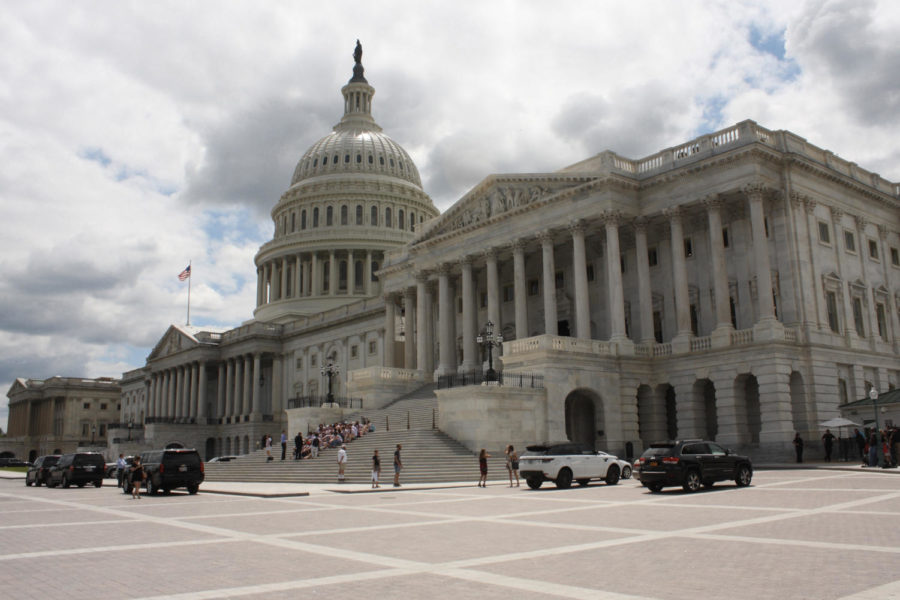Obscure Pentagon fund nets $2 billion, sets pork senses tingling
A view of the U.S. Capitol Building on July 25, 2017, in Washington, D.C. (Evan Golub/Zuma Press/TNS)
September 18, 2018
The Pentagon will soon have received about $2.3 billion in the last nine years — money the military never requested — for a special fund intended to help replace earmarks after Congress banned them, our analysis shows.
Buried deep inside the $674.4 billion Defense spending measure for fiscal 2019 that the Senate is expected to vote on this week is a chart with one line showing a $250 million appropriation for the Defense Rapid Innovation Fund, the latest installment of sizable funding for a largely unknown program that quietly disburses scores of contracts every year.
To supporters, the fund is a way to bankroll innovative systems that the military may not yet know it needs. To critics, the fund is just earmarking by another name.
The kinds of systems that net contracts from the innovation fund run the gamut. In fiscal 2016, they included programs to demonstrate artificial intelligence systems for aerial drones, anti-lock brakes for Humvees and underwater communications systems for undersea drones.
The systems may be technologies for which the military services have not yet established a requirement because they may not know what is technically possible. It is not clear how many of the systems actually become operational.
The defense fund’s eclipsing of the $2 billion mark comes as debate heats up in Washington over whether to revive earmarks. And the special account highlights key elements of that debate.
Earmarks have generally been defined as parochial spending, directed by lawmakers and received by people who have not competed for it.
In 2011, after earmarks were tied to several scandals and spending projects seen as excess, Congress barred them — or at least a narrow definition of them, critics contend, noting that, among other loopholes, committees could still add money for parochial projects without spelling out who supports them.
President Donald Trump suggested earlier this year that a return of earmarks, which were often used in horsetrading for votes, might be beneficial.
The House’s top Democrat, Minority Leader Steny H. Hoyer of Maryland, has suggested he would aim to bring back earmarks if his party takes control of the House next year. The senior Democrat on Senate Appropriations, Patrick J. Leahy of Vermont, has also supported a comeback for the practice. Republican leaders are less vocal right now, but many of them also support a return to earmarks.
“I don’t doubt that the next organizing conference for the next Congress will probably wrestle with this issue,” outgoing House Speaker Paul D. Ryan told reporters earlier this month.
The Defense Rapid Innovation Fund was launched in 2010 (first as the Rapid Innovation Program) in the fiscal 2011 defense authorization law. It was a way to capture what proponents called the innovative spirit of programs called earmarks that were clearly about to be banned.
Unlike earmarks, the defense fund’s money would be competitively awarded by the Pentagon, not directed by Congress, supporters of the idea pointed out.
Democrat Norm Dicks, then a senior Defense appropriator, and other advocates of the program described it at the time as a way to capture the innovation among smaller companies, including many who had received earmarks.
“We have not always had an adequate way of bringing these smaller firms and their innovation into the defense pipeline,” Dicks said in 2010.
Each year since its creation, the fund has received another installment of funds, never less than $175 million or more than $439 million.
The program has awarded several hundred contracts, averaging about $2 million each, mostly for small businesses with technologies that were relatively mature and that could address some military need, according to a fiscal 2017 Pentagon summary of the program’s results.
For fiscal 2019, the Pentagon again declined to request money for the program. The Senate Appropriations Committee also did not include funds for it. The House Appropriations Committee added the $250 million, and the House-Senate conference writing the final bill went along.
The House committee’s report said the panel “strongly encourages the Secretary of Defense to focus this program on the validation and transition of promising technologies developed by small businesses from the research and development stage through the prototype stage.”
The Senate is expected to approve the conference report later this week, and the House plans to clear the final package for Trump’s signature by the end of the month. The Defense bill is packaged in a measure with both the Labor-HHS-Education bill and a continuing resolution to keep the parts of the government that lack funding bills operating through Dec. 7.
But critics are unimpressed by claims that the fund is a font of competition and innovation. Many of the programs that have netted funding under the new program were the same ones that had garnered earmarks before they were officially banned, according to a 2015 study of the program by GOP Sen. Jeff Flake of Arizona.
“If defense earmarking before the earmark ban was a multi-billion dollar summer blockbuster, the RIF is simply its unfortunate sequel,” said Flake in his report, titled, “Jurassic Pork.”
Even if the programs have been technically open to competition, lawmakers, their staffs and lobbyists have steered the outcomes toward politically connected companies to favor initiatives that were not considered important enough to be part of the Pentagon’s budget request, the critics argue.
Winslow Wheeler, a former defense analyst with the Project on Government Oversight, calls the Pentagon fund a “shill operation” and said in a statement that it is “simply an indirect route for congressionally initiated projects that circumvented the new House rule on earmarks and its many loopholes.”
Likewise, Steve Ellis, vice president of Taxpayers for Common Sense, a government oversight group, said in a statement that the relative insignificance of the fund’s projects is reflected in the fact that no president has yet put it in a budget request for them.
“You would think that if the Pentagon really wanted the fund, they would start budgeting for it,” Ellis said. “Instead, lawmakers have shoveled billions of dollars into the account. This is all about finding places to stash the oodles of extra cash going to the Pentagon.”
Capitol Hill’s earmarking system mostly operated behind closed doors until 2009, when Congress began to require that members justify the directed spending requests in written documents that were publicly available. Congress later also barred earmarks for for-profit organizations.
Hoyer thinks that system worked.
By contrast, he has said, now those seeking appropriations that the president did not request have to get them “hat in hand” through the executive branch in a process that is not nearly as transparent.
Regardless, as long as corporate earmarks remain banned in Congress, there will be considerable pressure to permit mechanisms such as the special defense fund that give companies a way to secure funding even if the military did not ask for it.
The Pentagon did not respond to a request for comment on the issue.



